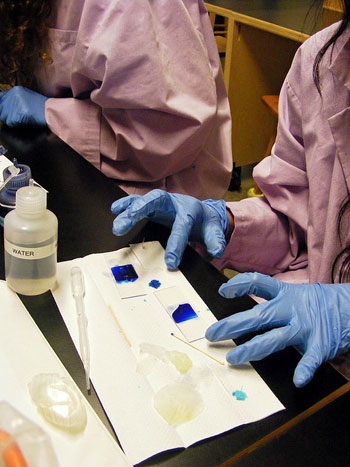"bioengineering" entries

The robotic worm
Does the way a brain is wired determine how we think and behave? Recent research points to a resounding yes.
Editor’s note: this is an excerpt from the latest edition of BioCoder; it is republished here with permission. Get your free copy of BioCoder Fall 2014 here.

One of the age-old questions has been whether the way a brain is wired, negating other attributes such as intracellular systems biology, will give rise to how we think and how we behave. We are not at the point yet to answer that question regarding the human brain. However, by using the well-mapped connectome of the nematode Caenorhabditis elegans (C. elegans, shown above), we were able to answer this question as a resounding yes, at least for simpler animals. Using a simple robot (a Lego Mindstorms EV3) and connecting sensors on the robot to stimulate specific simulated sensory neurons in an artificial connectome, and condensing worm muscle excitation to move a left and right motor on the robot, we observed worm-like behaviors in the robot based purely on environmental factors. Read more…

Connecting the microcosmos and the macro world
Christina Agapakis explores the microbiological matrix that binds everything from pecorino to people.

Cheese from the Selfmade project.
This is part of our investigation into synthetic biology and bioengineering. For more, download the new BioCoder Fall 2014 issue here.
Good luck trying to jam Christina Agapakis into any kind of vocational box. Her CV cites disparate accomplishments as a scientist, writer, and artist — and teacher. Imparting highly technical information in a compelling, even revelatory way seems part of, well, her DNA. She can’t not do it. Moreover, her career arc represents a syncretic impulse that characterizes her general outlook on life.
“A friend is starting a group called Doctors without Disciplinary Borders, and I’m joining it,” says Agapakis. “It captures the spirit of my work pretty well.”
Agapakis is first and foremost a synthetic biologist and a microbiologist, but she’s not particularly happy with the way the synthetic biology narrative has played out. She thinks biocoding is inadequately explained by its practitioners and deeply misunderstood by the lay public, raising excessive expectations and misunderstandings about what synthetic biology can do. The discipline’s message would be better communicated, she believes, if metaphors grounded in biology rather than computers were employed. Read more…

Looking for the next generation of biocoders
Natalie Kuldell on the hard work of bringing biocoding to the classroom.
 Synthetic biology is poised to change everything from energy development to food production to medicine — but there’s a bottleneck looming. How fast things develop depends on the number of people developing things. Let’s face it: there aren’t that many biocoders. Not in the universities, not in industry, not in the DIY sector. Not enough to change the world, at any rate. We have to ramp up.
Synthetic biology is poised to change everything from energy development to food production to medicine — but there’s a bottleneck looming. How fast things develop depends on the number of people developing things. Let’s face it: there aren’t that many biocoders. Not in the universities, not in industry, not in the DIY sector. Not enough to change the world, at any rate. We have to ramp up.
And that means we first must train teachers and define biocoding curricula. Not at the university level — try secondary, maybe even primary schools. That, of course, is a challenge. To get kids interested in synthetic biology, we have to do just that: get them interested. More to the point, get them jacked. Biocoding is incredibly exciting stuff, but that message isn’t getting across.
“Students think science and engineering is removed from daily life,” says Natalie Kuldell, an instructor of biological engineering at MIT. “We have to get them engaged, and connected to science and engineering — more specifically, bioengineering — in meaningful ways.”

Innovation requires a new mind-set: The O’Reilly Radar Podcast
Tim O'Reilly and Carl Bass discuss the future of making things, and Astro Teller on Google X's approach to solving big problems.
Editor’s note: you can subscribe to the O’Reilly Radar Podcast through iTunes, SoundCloud, or directly through our podcast’s RSS feed.
I recently lamented the lag in innovation in relation to the speed of technological advancements — do we really need a connected toaster that will sell itself if neglected? Subsequently, I had a conversation with Josh Clark that made me rethink that position; Clark pointed out that play is an important aspect of innovation, and that such whimsical creations as drum pants could ultimately lead to more profound innovations.
In the first segment of this podcast episode, Tim O’Reilly and Autodesk CEO Carl Bass have a wide-ranging discussion about the future of making things. Bass notes that innovation tends to start by “looking at the rear window”:
“The first naïve response is to take a new technology and do the old thing with it. It takes a while until you can start reimagining things…the first thing that you need is this new tool set in software, hardware, and materials, but the more important thing — and the more difficult thing, obviously — is a new mind-set. How are you going to think about this problem differently? How are you going to reimagine what you can do? That’s the exciting part.”